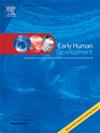Fetal bilateral hyperechogenic kidneys: Prenatal progression and long-term postnatal outcome
IF 2
3区 医学
Q2 OBSTETRICS & GYNECOLOGY
引用次数: 0
Abstract
Objective
To determine the prenatal progression and long-term outcome of fetal bilateral hyperechogenic kidneys (HK).
Design
Retrospective study 2005–2016. Fetal/maternal demographics, scan findings, postnatal diagnoses and outcomes were collected from electronic patient records and post-mortem reports.
Results
Data available for 65 out of 72 fetuses with bilateral HK. Forty-five (69 %) had normal amniotic fluid index (AFI); of these, 23 had isolated HK and all survived the neonatal period. The remaining patients with normal AFI had other renal and multi-system anomalies; diagnoses included 13 trisomies and genetic syndromes — only one patient with suspected bladder outlet obstruction survived. Of 20 pregnancies with reduced AFI, HK were isolated in 5 fetuses, and only one survived (diagnosed with 17q12 microdeletion). The remaining 15 fetuses had multisystem anomalies and none survived; diagnoses included Meckel-Gruber Syndrome and Dandy-Walker malformation. Survival with bilateral HK and oligohydramnios was 5 %. Overall survival was 25/65 (38 %); follow-up data was available for 23 patients. HK resolved in 17 (74 %) and persisted in 6 children, who were followed-up for median 15 years (4–19 years). Of these, 3 patients developed bilateral renal cysts and were diagnosed with HNF1b/17q12 deletion kidney disease (one patient is in CKD2a, whereas the rest have normal renal function). The remaining patients were found to have a PKD1 variant; bilateral renal cysts (lost to follow-up before a genetic diagnosis) and a unilateral hydronephrosis: all have normal renal function.
Conclusion
Isolated HK with normal AFI is associated with survival past the neonatal period and normal renal function in most cases (96 %). As normal kidney function may be due to glomerular hyperfiltration in early childhood to teenage years, long-term follow up is advisable, in particular for those with a genetic diagnosis that predisposes to chronic renal impairment in adulthood (HNF1b, 17q12 deletion in this study). HK in the presence of reduced AFI carries a poor prognosis, with only 5 % survival (this patient had 17q12 deletion related kidney disease). Overall survival in this study was 38 % in the first year and 34 % long-term.
胎儿双侧高回声肾:产前进展和长期产后结局
目的探讨胎儿双侧高回声肾(HK)的产前进展及远期预后。2005-2016年回顾性研究。从电子病历和尸检报告中收集了胎儿/母亲的人口统计数据、扫描结果、产后诊断和结果。结果72例双侧HK胎儿中有65例获得数据。45例(69%)羊水指数正常;其中23只分离出HK,全部存活于新生儿期。其余AFI正常的患者有其他肾脏和多系统异常;诊断包括13个三体和遗传综合征-只有一个病人怀疑膀胱出口梗阻存活。在20例AFI降低的妊娠中,5例胎儿分离出HK,只有1例存活(诊断为17q12微缺失)。其余15例胎儿多系统异常,无一存活;诊断包括Meckel-Gruber综合征和Dandy-Walker畸形。双侧HK和羊水过少的生存率为5%。总生存率为25/65 (38%);有23例患者的随访数据。17例(74%)患儿的HK消退,6例患儿持续,中位随访15年(4-19年)。其中,3例患者出现双侧肾囊肿,并被诊断为HNF1b/17q12缺失肾病(1例患者为CKD2a,其余患者肾功能正常)。其余患者被发现有PKD1变异;双侧肾囊肿(基因诊断前未随访)和单侧肾积水:均有正常肾功能。结论离体HK伴正常AFI的患者多数(96%)能存活过新生儿期,且肾功能正常。由于儿童早期至青少年时期肾小球过滤可能导致肾功能正常,因此建议长期随访,特别是对于那些遗传诊断为成年后易患慢性肾功能损害的患者(本研究中HNF1b, 17q12缺失)。伴有AFI降低的HK预后较差,生存率仅为5%(该患者患有与17q12缺失相关的肾脏疾病)。在这项研究中,第一年的总生存率为38%,长期生存率为34%。
本文章由计算机程序翻译,如有差异,请以英文原文为准。
求助全文
约1分钟内获得全文
求助全文
来源期刊

Early human development
医学-妇产科学
CiteScore
4.40
自引率
4.00%
发文量
100
审稿时长
46 days
期刊介绍:
Established as an authoritative, highly cited voice on early human development, Early Human Development provides a unique opportunity for researchers and clinicians to bridge the communication gap between disciplines. Creating a forum for the productive exchange of ideas concerning early human growth and development, the journal publishes original research and clinical papers with particular emphasis on the continuum between fetal life and the perinatal period; aspects of postnatal growth influenced by early events; and the safeguarding of the quality of human survival.
The first comprehensive and interdisciplinary journal in this area of growing importance, Early Human Development offers pertinent contributions to the following subject areas:
Fetology; perinatology; pediatrics; growth and development; obstetrics; reproduction and fertility; epidemiology; behavioural sciences; nutrition and metabolism; teratology; neurology; brain biology; developmental psychology and screening.
 求助内容:
求助内容: 应助结果提醒方式:
应助结果提醒方式:


